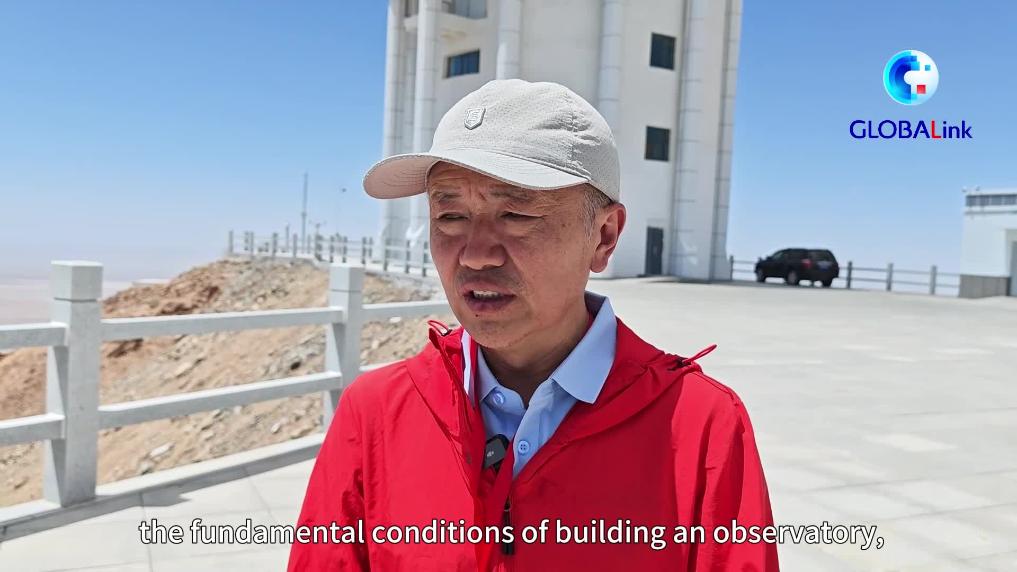Xinhua Headlines: China's former gritty oil town now explores glittering cosmos
Source: Xinhua
Editor: huaxia
2025-08-09 22:13:47
* Decades ago in its heyday, Lenghu pulsed with grit as home of China's "fourth largest oilfield," where workers braved sandstorms and thin air to pump the nation's industrial lifeblood. Today, these same winds still sweep across the mountaintops of Lenghu, which are now studded with telescopes -- their lenses trained on supernovae and black holes.
* In 2021, Lenghu was placed on the global astronomy map. Three consecutive years of data have confirmed that Serteng Mountain offers exceptional conditions for optical/infrared astronomical observation. Thus, this Gobi Desert town emerged as a source of salvation for Chinese astronomers long starved by a lack of world-class observation sites.
* From derricks to telescopes, Lenghu's rebirth is more than a local revival, but also a beacon for China's cosmic ambitions. After the last drop of its oil dried up, Lenghu managed to find a new lease of life via the shiny Milky Way -- ensuring another chapter in this tale of the same yet different town.
XINING, Aug. 9 (Xinhua) -- The wind howls through shattered walls and toppled structures, scouring the skeletal remains of a bygone era and whispering secrets of a town that refused to die.
Located in the city of Mangya, northwest China's Qinghai Province, the town of Lenghu derives its Mongolian-origin name from its lake's extreme cold.
Decades ago in its heyday, Lenghu pulsed with grit as home of China's "fourth largest oilfield," where workers braved sandstorms and thin air to pump the nation's industrial lifeblood. Today, these same winds still sweep across the mountaintops of Lenghu, which are now studded with telescopes -- their lenses trained on supernovae and black holes.
Situated in a remote corner of the Qaidam Basin, Lenghu was once defined by what lay beneath the earth. Now, however, it is betting its future on the stars above. Serving as a hub for astronomers and stargazers, the former oil town draws pilgrims devoted to the cosmos.
COSMIC GAMBLE IN THE GOBI
Our story begins in 1958 when a well named Dizhong-4, drilled in the Lenghu structure of the Qinghai Oilfield, one of new China's earliest developed oilfields, erupted in a spectacular blowout -- gushing 800 tonnes of crude daily. This dramatic event marked the birth of the Lenghu Oilfield.
Overnight, Lenghu became a frontier boomtown in the Gobi Desert, drawing tens of thousands of oil workers to its harsh embrace. They endured a land where "stones run before the wind and oxygen is never enough," forging a legacy encapsulated in what was later called the "Qaidam oilfield spirit" -- a mix of patriotism, entrepreneurship, dedication and hard work.
"The old-timers would tell us that just seeing that black gold shooting up makes all the backbreaking work suddenly mean something," recalled He Peng, director of the production support center at the Qinghai Oilfield's No.3 gas production plant, who grew up in Lenghu where his father worked in the oilfields.
In the 1990s, depleted wells triggered an exodus from Lenghu, with its population plummeting to fewer than 300. Today, ruins stand as silent witnesses to that concluded chapter of industrial fervor, while a towering monument in Lenghu's No. 4 Cemetery honors over 400 oilfield workers and their family members who had laid down their lives -- some on duty and others due to illness, in this frontier outpost.
"Lenghu is a typical resource-exhausted area, thus 'digging downwards' was no longer an option after the resources ran out," recalled Tian Cairang, who arrived in Lenghu in 2015 tasked with its transformation and who is now executive deputy director of the Lenghu sci-tech innovation industrial park management committee. "We had to break free from old mindsets," he said.
The breakthrough came unexpectedly during a 2017 survey mission. Lost after nightfall, Tian and his team were stunned by a celestial spectacle. This chance encounter with the amazing heavenly canvas above Lenghu had them wondering if maybe "Lenghu's future lay in looking up?"
Tian decided to invite Deng Licai, a researcher from the National Astronomical Observatories of the Chinese Academy of Sciences, to this almost empty town in China's northwest. Upon arrival at the foot of Serteng Mountain, Deng was immediately captivated. "This should be the place," Deng said as he photographed the luminous Milky Way arching overhead.
Tian and Deng's team braved crumbling steep slopes to scale the treacherous, over-4,000-meter peak to confirm its potential, marking their path with spray paint. Data soon revealed that this location was indeed an astronomical goldmine -- the site offered clear, dark skies more than 70 percent of the year, translating to 300 observable nights.
BUILDING ASTRONOMY BEACON
As bulldozers carved the winding gravel path up Serteng in 2018, helicopter logistics services were employed for transporting construction materials and observatory installation components. "To meet deadlines, we flew up to 80 sorties in a single day -- nearly nine hours in the air," recalled helicopter pilot Cui Feng.
In 2021, Deng's team published their findings in the journal Nature, placing Lenghu on the global astronomy map. Three consecutive years of data have confirmed that Serteng Mountain offers exceptional conditions for optical/infrared astronomical observation, they declared.
Thus, this Gobi Desert town emerged as a source of salvation for Chinese astronomers long starved by a lack of world-class observation sites.
"For a period, domestic research institutions struggled to find quality sites for their telescopes," Tian noted. Universities and observatories flocked to this remote plateau. By 2022, Qinghai Province designated Lenghu a top-tier national innovation platform -- with annual funding of 10 million yuan (about 1.4 million U.S. dollars).
Now, telescopes punctuate Serteng's ridges like silent sentinels. Dominating the C Platform at 4,200 meters is Mozi, the Wide Field Survey Telescope (WFST) nicknamed after the ancient Chinese philosopher Mozi. He is said to be the first person in history to have conducted optical experiments.
A joint project between the University of Science and Technology of China and the Purple Mountain Observatory of the Chinese Academy of Sciences, Mozi is currently the most powerful optical time-domain survey facility in the Northern Hemisphere.
Since operations began in September 2023, Mozi has discovered over 4,200 supernovae and transient candidates, while building Asia's largest supernova multi-band photometric database. Its recent high-frequency monitoring of the Milky Way revealed rare, rapidly variable stars.
"We study highly active celestial bodies in the universe," said Kong Xu, chief designer of Mozi, adding that time-domain astronomy is crucial for exploring gravitational waves, hunting black holes and confirming supernovae.
Also on the Serteng Mountain, construction began last month on the auxiliary monitoring system for the Expanding Aperture Segmented Telescope at the Lenghu Astronomical Observation Base. Forty-five telescopes representing 12 institutions now call Lenghu home -- amounting to scientific investments totaling 3 billion yuan, according to Cao Chunlin with the Lenghu sci-tech innovation industrial park management committee.
GUARDING GOLDEN DARKNESS
The astronomical renaissance in Lenghu is built on one irreplaceable yet extremely fragile resource -- pristine darkness.
Astronomers are well aware of how crucial such darkness is in their field of work. Light pollution has forced observatories into repeated relocations all around the world. Tokyo Astronomical Observatory, for example, moved multiple times before establishing telescopes in Hawaii, and so did observatories in California and Arizona in the United States.
China's observatories faced similar challenges. The Purple Mountain Observatory in Nanjing, once atop Purple Mountain, eventually had to relocate due to the urban skyglow in this city in east China's Jiangsu Province.
"Dark night skies are the fundamental condition for an astronomical observatory's existence," Deng said, noting that without such darkness, ground-based optical observation becomes impossible. Lenghu, notably, faced a paradox -- success in the field of astronomy and nascent tourism threatened the pristine skies it relied on.
Balancing development with preservation became paramount. The solution arrived with unprecedented force in 2023 when the Mongolian-Tibetan Autonomous Prefecture of Haixi, where Lenghu is located, enacted China's first local legislation dedicated to dark sky protection -- namely the regulations on the protection of the astronomical observation environment in Lenghu.
This landmark legislation strictly controls light types, brightness and beam direction across Lenghu's entire 17,800 square kilometers, designated as a dark sky reserve. "The dark night sky is Lenghu's invaluable asset," Tian said.
Enforcement is rigorous. Three planned new energy projects were relocated and strict approval processes govern core and buffer zones, while local authorities secured pledges from businesses to prevent light pollution. "These regulations help curb pollution at its source," said Cao -- who noted that protecting the darkness safeguards astronomy and charts a sustainable development path.
With more telescopes set to be deployed, the Lenghu base has the potential to become one of the world's largest observatories, Deng said, envisioning it as a global hub for cosmic discovery.
From derricks to telescopes, Lenghu's rebirth is more than a local revival, but also a beacon for China's cosmic ambitions. After the last drop of its oil dried up, Lenghu managed to find a new lease of life via the shiny Milky Way -- ensuring another chapter in this tale of the same yet different town.
(Video reporters: Yang Zeyi, Chen Jie, Shi Weiyan; Video editors: Yang Zeyi, Hui Peipei) ■











Comments